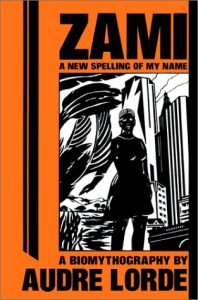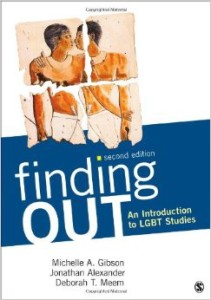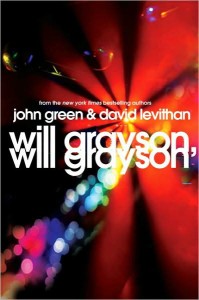This course will provide an introduction into Lesbian, Gay, Bisexual, Transgender, and Queer (LGBTQ) Studies. Considering LGBTQ Studies as an interdisciplinary field, this course will focus on how the central concepts of sexual orientation and gender identity work within history, politics, literature, technology, art, music, philosophy, education, and psychology. Throughout this course, students will work towards a deep understanding of the intersectional dynamics of privilege and oppression as they relate to LGBTQ individuals and culture by exploring the lived experiences of LGBTQ people.
This course was developed as part of an independent study group of UW-Waukesha students that I directed in Spring 2012. It is the only class in the UW Colleges that was created by students.
 |
 |
 |
Learning Objectives
- Critically read, discuss, analyze, and write about the assigned readings and central course themes. A key part of this process will be the application of course concepts to current cultural conversations and, potentially, students’ lived experiences.
- Build both a specific and general knowledge of the history and current dialogues regarding LGBTQ issues across multiple disciplines and across multiple forms of media concerning a variety of issues related to sexual orientation and gender identity (e.g., journal articles, online resources, textbook readings, film, and literature, and music).
- Understand the concepts of gender and sexuality [unpacking foundational social concepts that structure how we move in the world and understand ourselves] as intersecting with other categories of identity through the development of critical thinking and problem solving skills, which in turn are necessary skills for interacting with and responding to diverse groups of people, particularly in LGBTQ communities
Full Schedule of Readings and Assignments
Book List
- Michelle A. Gibson, Jonathan Alexander, and Deborah T. Meem. Finding Out: An Introduction to LGBT Studies. 2nd Edition. Sage, 2013.
- Bornstein, Kate. My New Gender Workbook: A Step-by-Step Guide to Achieving World Peace Through Gender Anarchy and Sex Positivity. 2nd Ed. Routledge. 2013.
- Gold, Rachel. Being Emily. Bella Books, 2012.
- Green, John and David Levithan. Will Grayson, Will Grayson. Penguin Books, 2011.
- Lorde, Audre. Zami: A New Spelling of My Name. The Crossing Press, 1982.
Projects and Assignments
Discussion Facilitation
For one class period each, pairs of students formulate two discussion questions and then facilitate the in-class discussion of those questions. Students are expected to have done a little bit of background research into the text in order to establish a context for their questions.
Blog Posts (4 reading responses; 3 personal reflections; 3 comments on others’ posts)
Each student must post four readings responses (prompts to be distributed throughout the term) to specific reading assignments, three personal reflections on how the course is/is not influencing how their views of popular culture, other courses, and (if they choose) their personal life, and three follow-up responses to others’ responses. While these posts need not be polished pieces of writing, I do expect a certain amount critical thought. The idea here is raise issues about a particular reading or group of readings for the class and start to contextualize those readings in terms of previous class discussions before we discuss the texts in class.
Photovoice Project: Understanding Social Privilege, Heterosexual, and/or Cisgender Privilege
This assignment is designed to help students to develop insight into their experiences with privilege/oppression related to sexual orientation and/or gender identity/expression. This is a creative, expressive activity which requires students to think and reflect on the concept of privilege. For this activity, they use a camera to represent their understanding of the term Heterosexual and/or Cisgender Privilege. Students can check out a camera from the library if they do not own a camera. The goal here is to think about the terms Heterosexual and/or Cisgender Privilege and what it means to them. Students take a picture that represents their understanding of the term. To contextualize the meaning of their picture, students attach the picture with a 3-4 page description including the following:
- Describe the picture.
- What is happening in the picture?
- What does the picture tell us about your life?
- How does this picture demonstrate privilege?
- What does this picture tell us about those who do not experience the privilege not represented in your picture?
(Social Privilege: A right, advantage, or immunity granted to or enjoyed by certain people beyond the common advantage of all others; an exemption in many particular cases from certain burdens or liabilities. A person can enjoy certain privileges based on things like their race, ethnicity, ability, body size, sexual orientation, etc.)
Current Events Analysis Paper
In this assignment, students write a 4-5 page paper on a specific topic related to current events in the context of the overall LGBTQ Rights Movement. In their papers, students identify the historical and global context of the issue, what obstacles/barriers are in place in relation to forward movement, a critical analysis of how this issue has been covered by the media, and what gains have been made and what still needs to occur to create more equitable conditions for LGBTQ individuals.
Advocacy Project & Self-Assessment Essay
Over the course of the semester, students work with a small group to develop their own individual social justice project that addresses concerns of LGBTQ Community. Their projects are intervention plans that can take place on a community, department, disciplinary, college, university, state, or national level. This plan can take many forms, and I encourage students to relate it their your major fields of study. Examples of projects include but are not limited to the following: a multi-session lesson plan, a computer program, an original work of art, an analysis of trends in popular culture or literature, creation of a web resource, a concrete political action plan for a particular issue, a historical analysis of LGBTQ history, a reflection on and analysis of one’s work with a LGBTQ organization or publication, and an original work of queer theory.
Students present these projects to the class during the final weeks of the class. In their presentations, they identify why the issue is of importance to the LGBTQ Community, what intervention they have chosen to address this issue, and the anticipated results of their actions.
Students also complete essays in which they explain their interventions, demonstrate how it builds from at least three course texts, and assess its efficacy in accomplishing its goal. I encourage students to acknowledge the limits of their interventions and suggest avenues for further work in this area.
Here are a few examples of student projects:
